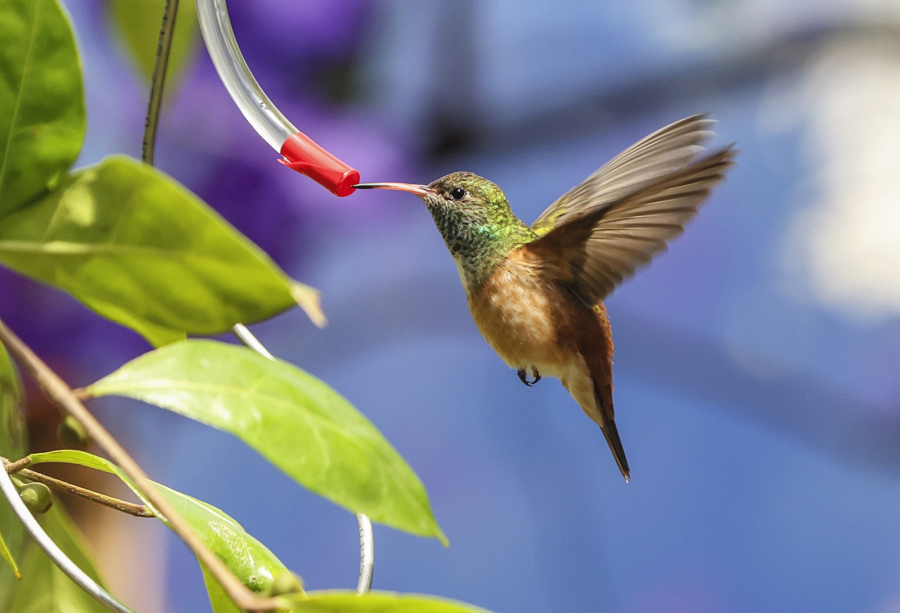SAN DIEGO — The San Diego Zoo’s two newest exhibits offer a glimpse of some of the world’s smallest birds and its largest, most fearsome lizards.
On June 8, the zoo debuted its new Komodo dragon and hummingbird habits, located near the Reptile House and the Children’s Zoo, which opens later this year.
The Kenneth C. Griffin Komodo Kingdom and William E. Cole Hummingbird Habitat took more than four years and $10 million to complete. And Nadine Lamberski, chief conservation officer for the San Diego Zoo Wildlife Alliance, hopes guests walk away from both habitats with a newfound appreciation for the roles these animals play in their natural environments — and how their ecosystems would suffer without them.
“What we’re really trying to do is establish connections between people and wildlife and create an environment where we can talk about the interconnectedness of people, wildlife and the environment,” Lamberski said.
Here’s what you can expect at the new exhibits.
Komodo Kingdom
This 2,700-square-foot habitat, adjacent to the Reptile House, transports you to hot and humid Komodo Island, one of five Indonesian islands home to the largest lizards on Earth.
You’ll meet two Komodo dragons: Ratu, a 10-year-old, 60-pound female, and Satu, a 17-year-old, 135-pound male. Ratu has been at the San Diego Zoo since 2012, while Satu was recently transferred from a zoo in Florida.
The lizards will be able to explore habitats that mimic the beaches, mountains and forests of Komodo Island. The mountain- and forest-themed exhibits are specially designed to stay around 80 degrees and 70 percent to 80 percent humidity.
The exhibits also feature heated rocks that can reach 105 degrees, allowing the cold-blooded creatures to quickly warm up.
Komodo dragons can grow up to 10 feet long and weigh more than 175 pounds. Their bodies are covered in tough, pebbled skin reinforced with bony plates that protect them from scratches and bites — a bit like how chain mail protected medieval warriors on the battlefield.
At the zoo, these animals feast on fish, rats and chunks of lamb, but in the wild, Komodo dragons often hunt deer, wild boar and even water buffalo.
But while it’s easy to think these apex predators are invincible, habitat loss, tourism and illegal poaching have left them vulnerable to extinction, according to the International Union for Conservation Research. That’s a problem, Lamberski says, because of the vital role Komodo dragons play in controlling prey populations and clearing animal carcasses.
“If this species is gone and that role in nature is no longer being filled,” she said, “that ecosystem becomes less healthy.”
Hummingbird Habitat
Brace yourself for a cacophony of calls and whirring of wings the moment you step inside the 3,800-square-foot hummingbird habitat, a larger, revamped version of an exhibit that has been at the zoo since 1964.
The habitat is home to 40 birds from 17 species in total, all native to the Americas, according to David Rimlinger, curator of ornithology. That includes three species of hummingbirds: Anna’s and Costa’s hummingbirds, native to San Diego, and Emerald hummingbirds, found in Central America.
You’ll probably see the hummingbirds in this walk-through exhibit zipping from one feeder to the next non-stop, imbibing a special solution packed with sugar, protein, vitamins and minerals.
If you’re looking to help your local hummingbirds, Rimlinger says there are two simple things you can do. One is to fill your garden with the kind of colorful flowering plants hummingbirds love, such as orchids or the appropriately named hummingbird sage.
Another option is to put out a hummingbird feeder filled with four parts water and one part sugar. You can boil the mixture and let it cool to room temperature before filling your feeder.
The key, Rimlinger says, is to regularly replace the sugary liquid before bacteria and fungi build up.



